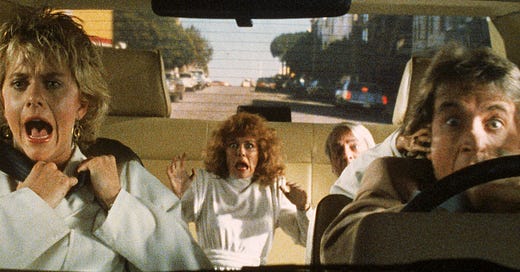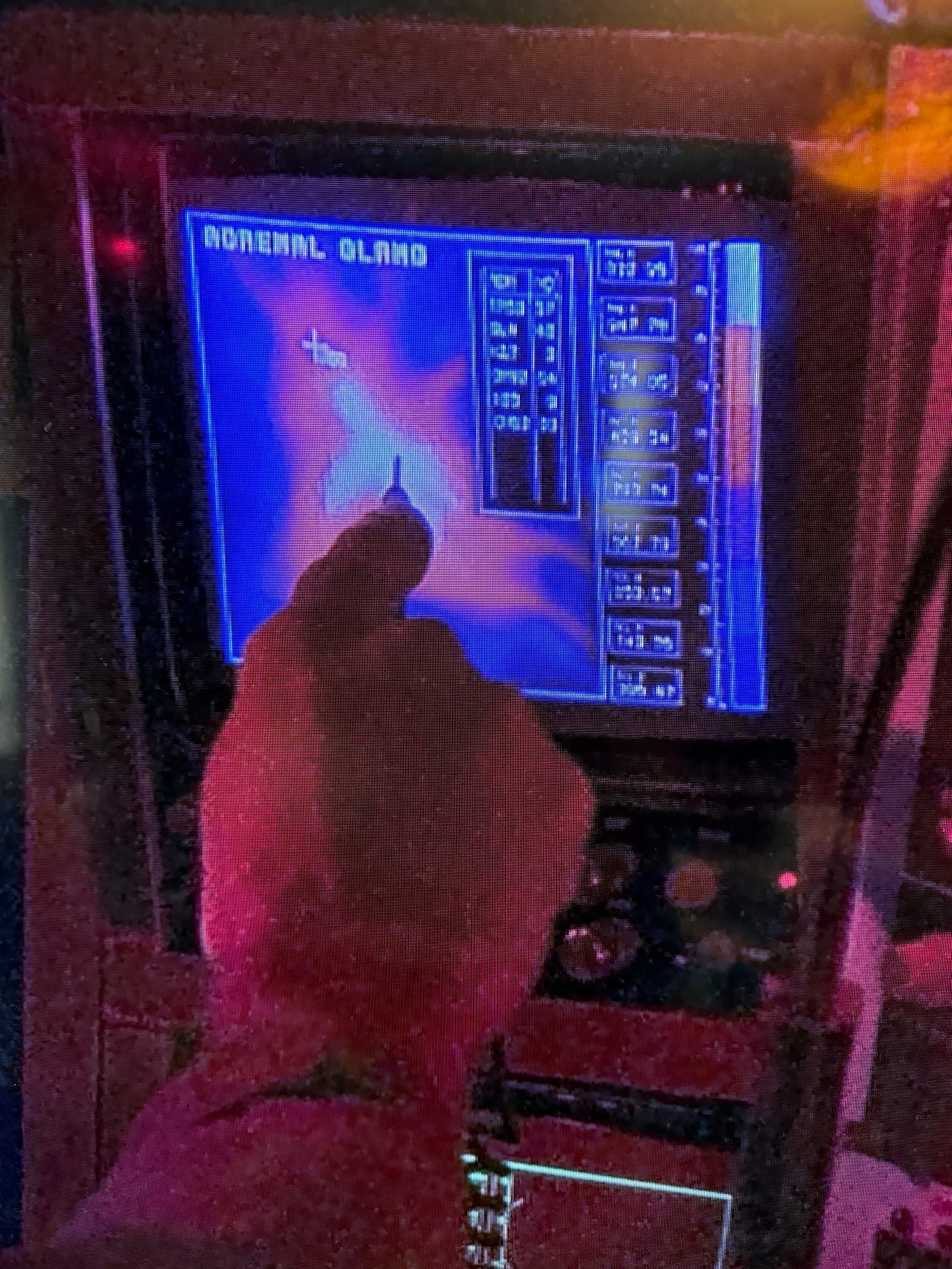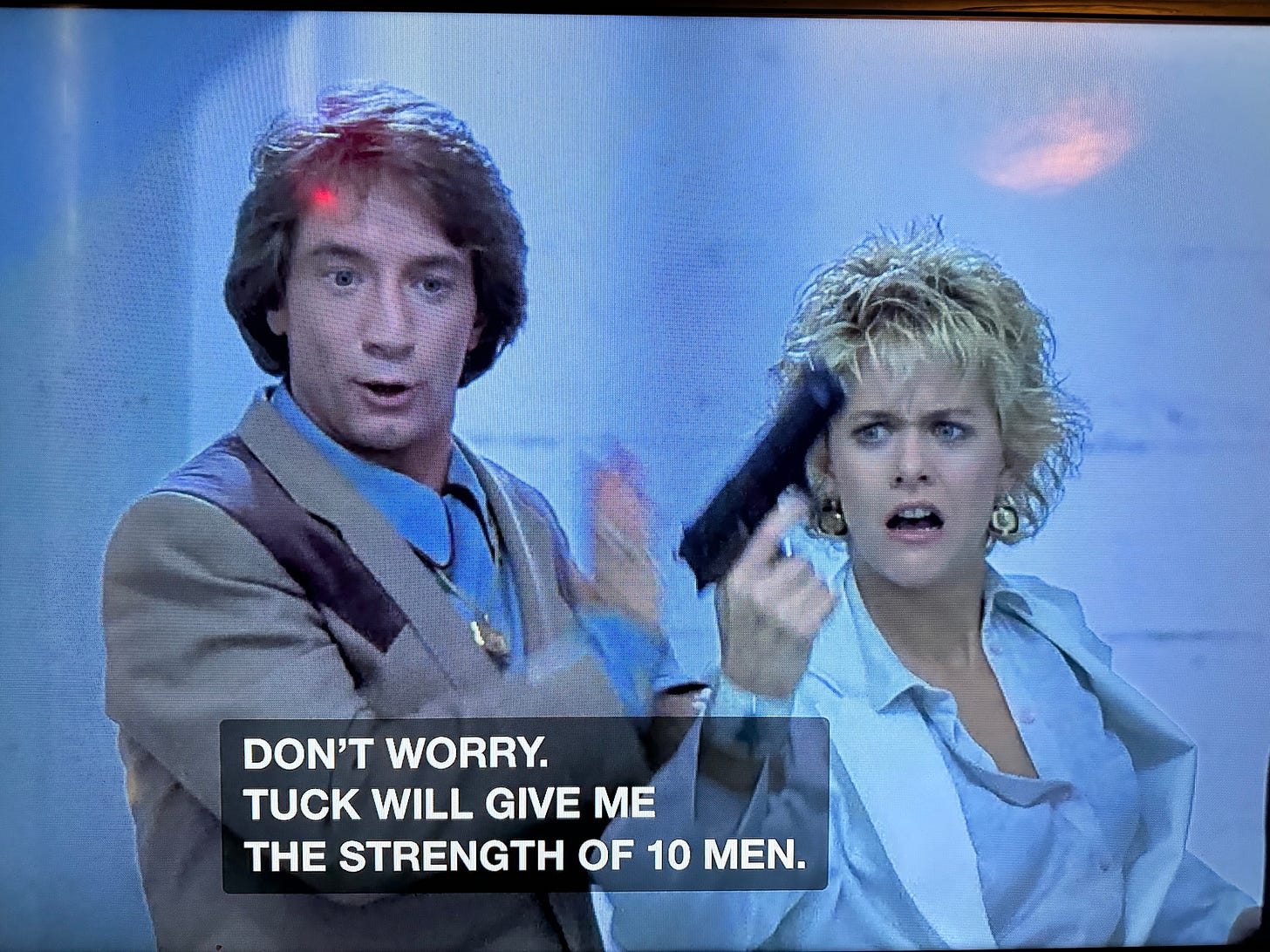My family’s inter-generational movie night adventure continues, and this week my children made me watch IF (2024) and Wish (2023), neither of which I can recommend. I countered with Innerspace (1987), a film I vaguely remembered entirely loving when I was 12 years old.
The first signs of trouble came with the trailer: one of my kids likes to watch the trailers before the movies just to have a sense of what she’s in for. The trailer was bad even by 1980s standards and sent her into a howling, crying fit of angst: “I don’t want to watch it!!” When we calmed her down and got her back into the TV room (the only room in the house with a TV — it’s like 22 inches, don’t picture anything too grand here), she asked how long the movie was. We looked: 2 hours. Cue round two of crying.
But two hours later, the same child was amazed: “wow, two hours goes by really fast when you’re watching a good movie!”
Before writing this, I decided to look up the basic details about the film on Wikipedia. There was so much I hadn’t remembered: I didn’t remember that Meg Ryan was in it at all (I don’t think she was famous back then), and I didn’t know that the absolutely ridiculous character “The Cowboy” had been played by the absolutely perfect-for-the role Robert Picardo (better-known as Star Trek: Voyager’s Holographic doctor).
(The music is also by Jerry Goldsmith, who composed Voyager’s gorgeous opening theme.)
And for SCTV fans, there’s a cameo-ish short scene with Andrea Martin and Joe Flaherty.
I learned by looking it up that this film was directed by COMPLETE WEIRDO Joe Dante, that it was only successfully made because Steven Spielberg (Producer) protected it FROM HIS OWN STUDIO, and that like the other great under-recognized classic of its era, Demolition Man (1993), Innerspace was originally pitched as a serious film, and was re-written to be a comedy. But the studio’s marketing wing was hostile to the film, thought Martin Short was too “unattractive,” and they didn’t promote it well — and indeed, even today, a kid who eventually ended up thinking it was a great, fun movie was literally WEEPING at the prospect of being forced to watch it after seeing its trailer.
Now that’s a BAD trailer.
For the pure fun of it, I recommend re-watching (or just watching) this movie, but in doing so I have to emphasize, this story is genuinely silly — please leave your knowledge of biology, physics, and general logic in the pocket of your other pants.
It’s also remarkably non-violent: in a scene where a group of literal corporate robbers invades a laboratory by force, they use some kind of “knock out gas” on everyone there, rather than shooting or harming anyone. Only one “good” person dies in the whole film, and he is a scientist who dies nobly rescuing the life of Dennis Quaid’s “Tuck Pendleton,” the test pilot shrunk down into a syringe. Also, only one “bad guy” dies, and he’s the bad guy who killed that scientist (and is kind of actually a movie-monster cyborg). So one of the ways that the movie is “silly” and not like the real world is that it’s much less violent than the real world, even though the film is definitely an action adventure fantasy.
I’m going to get over-literal in my take on this film for a second, but not because swapping spit in a kiss wouldn’t allow a mini-man in a Fantastic Voyage-like meat-navigating submarine accidental access to a woman’s uterus; nor am I going to question the purported utility of a program to restructure the facial musculature of a rabbit (let alone its supposed mechanism)… or question any of the other crazy shit that happens in this story.
No, instead I’m going to reflect on the “message” of the film, which is that a fragile, neurotic individual who everyone says needs rest and “a break” is actually better-served by going on a terrifying adventure that pushes him to do things he never dreamed he could do. The adventure itself is ridiculous, yes, but the courage this anxiety-riven Martin Short character has to muster in the course of it is actually very well done. In other words, what’s happening outside of him is a circus, but what’s happening inside of him is art.
First, he experiences his polar-opposite, Tuck, as a “voice” in his head. They’re in opposition until he’s attacked — and Tuck helps him survive and escape. Then, they learn through Jack’s ears that Tuck is about to be betrayed, and Jack (Martin Short) decides to help Tuck back. He has to run and grab this other man’s jacket to get his car keys; now he’s wearing his jacket and driving his (incredibly hot red convertible) car. Pretty soon, the test pilot’s brilliant, gorgeous, investigative journalist girlfriend is in the passenger seat. It’s like he’s trying on Tuck’s life. But he’s still in control: sometimes he says what Tuck tells him to, other times he chooses not to. Sometimes he’s does what he’s told, other times he doesn’t. Every new terror he survives makes him stronger, less anxious, more confident. But new terrors are always on the way.
There’s a central scene when he’s about to get into a physical confrontation and can barely grit out his teeth to Tuck that he “feels. so. HOSTILE towards you right now.” Tuck says yeah, that’s because I’m stimulating your adrenal gland, but Jack’s not sure that’s why he’s so mad. Still, he clocks Robert Picardo’s “Cowboy” with one knockout punch. Then, he not only tries on the Cowboy’s clothes, he wears his face.
Later, when he doesn’t realize that Tuck’s left his body, he fights his own battle, thinking that Tuck will use his biological trickery to help him again:
But soon he realizes that he’s on his own. And tho he says, “Hello, Mr. Killer” in a timid voice, he follows that by kicking Mr. Killer in the face.
One of the cute quirks of the “Tuck Pendleton” character is that he likes to psych himself up by looking himself in the mirror, smacking his own face (affectionately) and declaring the “Tuck Pendleton Machine” has “Zero Defects.” When he’s riding inside Jack, he has him look in the mirror so he can do it with his host’s face. It’s an interesting idea: that a test pilot considers his own body the machine he’s piloting, and so if he’s (somehow) put into another person’s body, it’s pretty easy for him to adapt to piloting that other guy, just as well.
This movie is kind of like Fantastic Voyage and kind of like Cyrano de Bergerac but mostly it’s its own very strange creature, in which the plot follows the comedy down some very strange rabbit holes, like having the baddies play out the entire last act at 50% their normal size. In the end it’s a story that says if you’re nervous about life, the solution isn’t to “avoid excitement,” it’s to seek it out. The three pillars of Jack’s life when we meet him are his doctor, his boss, and Wendy, the girl who recently stood him up for a date. At the end, he tells them, “Doctor, I’m cured. Wendy, I’m not interested. Mr. Wormood, I quit.” His life sucked, and he leaves it, recklessly, to chase after the silly circus that is moving on to the next town.
Also, the villain’s dog is frickin gorgeous. :)









The music from the trailer is almost identical to the music in The Goonies. Like most 80s movies, Innerspace holds a special place, sort of like Short Circuit. They are cheesy and often overacted, but so nostalgically wonderful. 😁
Thanks for sharing a great review, Amy!
That was a really fun revisit to a really wacky movie. I love Martin Short.